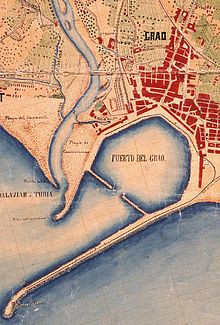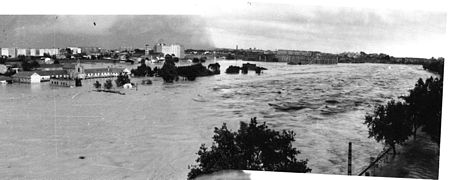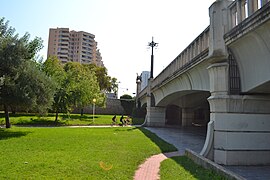Great flood of Valencia in 1957
The great flood of Valencia on October 14, 1957 was a flood of the Rio Turia in Valencia . The disaster killed at least 81 people and caused immense material damage. As a result, the river was diverted through an artificial river bed. Today the river runs south of Valencia and flows into the Mediterranean Sea between the port of Valencia and the district of Pinedo .

prehistory
Valencia goes back to a Roman city foundation from the year 138 BC. BC, located on a river island in the mouth of the Rio Turia in the immediate vicinity of the Mediterranean Sea. One confluence of the Turia was in the Nazaret district, the other in the Grao district. The sea level was then about 4 m below the current level. The location of the foundation was chosen at a higher point, which was the only one spared during the flood. Water overflowing its banks has been recorded in the city chronicles since the 14th century. After there had been around 400 to 500 deaths in the flood of August 13, 1356, Peter IV , King of Aragon, set up the "Junta de Murs i Valls" (in German "Council for Walls and Walls"), which through the newly founded "Fábrica de Murs i Valls" acted. The task of the council was, in addition to the maintenance of the outer walls of the city and other facilities of the infrastructure, later also the containment of the Rio Turia. However, it was not until another flood on October 20, 1589 that the decisive impetus for the construction of dams came about. The extent of the new flood and the danger of a revolting urban population prompted King Philip II of Spain to issue a royal decree to oblige the city fathers of Valencia to take appropriate measures "with extraordinary care" to prevent a new flood disaster. The new tax on meat consumption levied for financing subsequently even led to a dispute with the Pope. As a result, the Nueva Fábrica del Rio was founded (1590), a branch of the Fabrica de Murs i Valls, whose explicit task was to contain the course of the river. But the river could not be tamed through the centuries. A forerunner of the great 1957 flood occurred in 1949 with the San Miguel Flood (September 29). This was named after the saint's name day and above all washed away the poor and refugee settlement on the bank of the river, which was poorly built during the Spanish Civil War . As a result, dams were built on the left bank of the Turia between the Campanar and San José bridges, which were completed in 1953, but still could not stand up to the water masses of the great flood.
Causes and course
According to current knowledge, the causes of the flood can be seen in unusually heavy precipitation lasting over two days. The tide played out in two waves. The first wave hit Valencia on the night of October 13-14. The main cause was precipitation, which initially concentrated upstream, in Campo de Turia, north of Valencia. While only 2.8 l / m² of rain fell in Valencia from the morning of October 13 to the morning of October 14, outside the city it was much more: in Villar del Arzobispo 235 l / m² were measured in the same period, in Chelva 217 l / m² and in casinos 200 l / m². The residents of the city were therefore in no way forewarned, while the water masses accumulated in the Turia basin and in the tributaries. Around noon on October 14th, heavy rains set in in Valencia, measured 125 l / m² (90 l / m² within 40 min), at the same time as the arrival of the second wave of water through the river. The normal flow rate of the Turia, which was 165 m³ / s immediately before the flood, increased dramatically to 2700 m³ / s during the first wave and at the height of the second wave the discharge reached 3700 m³ / s. The water overflowing the banks floods streets and squares. While the historic old town (Plaza de la Reina, Plaza de la Virgen, etc.), which dates back to the founding of the Roman city, was spared, the water level in the lower districts reached a level of up to five meters in Calle Doctór Olóriz, in Jardines del Parterre up to 3 , 20 m, in Calle Pintor Sorolla 2.70 m and in Plaza Tetuán 2.25 m.
An effective crisis management by the mayor and the regional representative of the national government did not take place, as they themselves were trapped by the water masses and had to be saved. The government and administration buildings were flooded, telephone connections, electricity and water supplies collapsed. The flood claimed a total of 81 lives. 52 in the city of Valencia and 29 in the surrounding area. Of these, 14 could not be identified and 15 were pronounced dead after they had not been found. In February of the following year, the sea washed ashore dead people who were attributed to the flood disaster. The victims were primarily old people who were surprised by the water and children. The damage to private and public buildings and facilities such as houses, newspapers, banks, schools and theaters was thousands of times over. The economic damage to businesses and the city was enormous. 5,580 affected commercial enterprises complained about damage to machines, real estate and inventory amounting to 1 billion pesetas . In agriculture, the damage amounted to 760 million pesetas. Roads and paths suffered damage amounting to 81 million pesetas; buildings and facilities of the city administration alone were damaged by 326 million pesetas. The city and region only recovered slowly from the damage.
consequences
As a result, the Valencia City Council came to the decision to divert the river. With the so-called "Plan Sur" it was decided against a new fortification of the banks with dams and a diversion in the south of the city. The riverbed of the Turia, which was thus drained, was intended to be used for an urban motorway, according to the will of the city planners, but the population of Valencia advocated natural use. With the Jardín del Turia ( Turia Garden), a green area running through the entire city with a length of seven kilometers and an area of 1,100,000 m² was created. This has created one of the largest contiguous inner-city parks and recreation facilities in Spain. On October 17, 1982, a memorial by the sculptor Ramón de Soto Arándiga for the victims of the flood was inaugurated there.
Web links
- https://www.tiempo.com/ram/1178/las-riadas-del-turia-en-valencia/
- http://eltiempo.lasprovincias.es/las-cosas-del-clima/riada-valencia-del-14-octubre-1957
- http://www.levante-emv.com/valencia/2017/10/04/riada-57-valencia-aniversario-60-anos/1623886.html
- http://www.eldiario.es/cv/valencia/Radiografia-riada-dejo-muertos-Valencia_0_569393129.html
Individual evidence
- ^ Barry Cunliffe: Europe between the Oceans. 9000 BC-AD 1000. New Haven 2008, p. 63.
- ^ [1] La Junta de Murs i Valls. Historia de las obras públicas en la Valencia del Antiguo Regímen by Vicente Melió Uribe, p. 239
- ↑ [2] Las Provincias, March 3, 2012. Retrieved October 16, 2017
- ↑ [3] Las Provincias, October 13, 2016. Retrieved October 16, 2017
- ↑ [4] El Diario, October 14, 2016. Accessed October 17, 2017
- ↑ [5] Economìa 3 of October 16, 2017. Retrieved October 18, 2017.
- ^ [6] Website of the City of Valencia. Retrieved October 18, 2017










